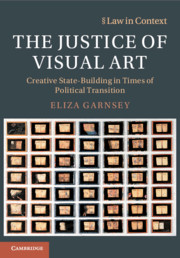Book contents
- The Justice of Visual Art
- The Law in Context Series
- The Justice of Visual Art
- Copyright page
- Dedication
- Contents
- Figures
- Acknowledgements
- Abbreviations
- 1 Introduction
- 2 Art and Justice in Times of Transition
- Part I Recognising Transitional Justice in the Nation State
- Part II Representing Transitional Justice on the Global Stage
- 7 From Banned to Embraced
- 8 Mapping Political Art-Scapes
- 9 The Art of Representation
- 10 The Cultural Diplomacy of Imaginary Fact
- 11 Conclusion
- References
- Index
10 - The Cultural Diplomacy of Imaginary Fact
from Part II - Representing Transitional Justice on the Global Stage
Published online by Cambridge University Press: 17 October 2019
- The Justice of Visual Art
- The Law in Context Series
- The Justice of Visual Art
- Copyright page
- Dedication
- Contents
- Figures
- Acknowledgements
- Abbreviations
- 1 Introduction
- 2 Art and Justice in Times of Transition
- Part I Recognising Transitional Justice in the Nation State
- Part II Representing Transitional Justice on the Global Stage
- 7 From Banned to Embraced
- 8 Mapping Political Art-Scapes
- 9 The Art of Representation
- 10 The Cultural Diplomacy of Imaginary Fact
- 11 Conclusion
- References
- Index
Summary
Chapter 10, The Cultural Diplomacy of Imaginary Fact, theorises the exhibition in the 2013 South Africa Pavilion at the International Art Biennale in Venice as a unique instance of cultural diplomacy. Imaginary Fact plays a paradoxical role in the process of nation building because it presents a dual image of a nation struggling with ongoing internal complexities, while projecting a collective narrative of a state that has undergone a difficult transition and come out the other side to re-assert itself in the international community.By examining South Africa’s conception of cultural diplomacy presented in government white papers, I show how the official image of South Africa as a global competitor (a transitioned nation) sits uncomfortably with the artists’ image of South Africa as a transitioning nation circumscribed by ongoing challenges to human rights.I argue that this establishes a glocal (global–local) image of the state which is in tension with South Africa’s foreign policy agenda.
Keywords
- Type
- Chapter
- Information
- The Justice of Visual ArtCreative State-Building in Times of Political Transition, pp. 193 - 204Publisher: Cambridge University PressPrint publication year: 2019

